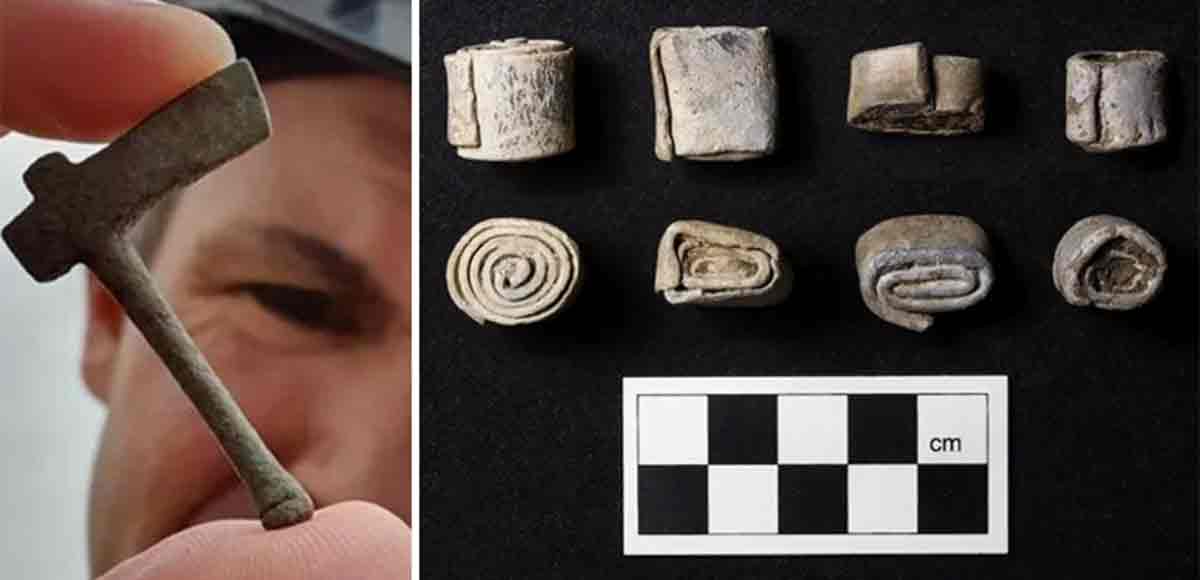Remarkable Roman Villa Unearthed from a Bronze Age Site in England
A Bronze Age site in England, housing a ‘richly decorated Roman villa’ from a later period, has revealed a bounty of artifacts and architectural evidence, which includes aisled buildings adorned with painted plaster, mosaics, and ornate tile work. Evolving over time, the complex featured several buildings from the late first and second centuries, with four enormous column or post bases, among the largest from the Roman era in Britain!
- Medieval Roman Colony Found in Nola: Hub of Arts & Crafts
- Luxury Bath Spa at Rutland Villa Was a Roman Barn Conversion
A Richly Decorated Villa and Ritualistic Artifacts
Situated in Grove village in Oxfordshire, with a history dating back to the Bronze Age, the site now named Brookside Meadows was occupied by Romans from the first or second centuries until the late fourth or early fifth century, reports the Red River Archaeology Group (RRAG). By this time, Britain (or Britannia) would go on to slip out of Roman control, as the Roman empire unto itself began collapsing.

The discovery was made at Brookside Meadows in Grove, near Wantage, Oxfordshire. (Red River Archaeology Group)
Beginning with Julius Caesar's expeditions in 55 and 54 BC, the Romans gradually established their authority over Britain, culminating in the Claudian invasion of 43 AD. The conquest led to the establishment of Roman rule, which lasted for nearly four centuries.
The decline of the Western Roman Empire in the 4th and 5th centuries, coupled with external pressures and internal instability, led to the gradual withdrawal of Roman forces from Britain by the early 5th century, marking the end of Roman rule and the beginning of the Anglo-Saxon period in British history.
"The sheer size of the buildings that still survive and the richness of goods recovered suggest this was a dominant feature in the locality, if not the wider landscape," said Louis Stafford, a senior project manager at RRAG.
- How A Roman Sacred Site Became A 300-AD Tile and Brick Factory
- Islamic Tower Found “In” Roman Villa on A Spanish Beach

The complex comprised numerous structures, with one likely featuring multiple storeys. (Red River Archaeology Group / SUMO GeoSurveys.)
The Roman Villa: Small Administrative Center unto Itself
Roman villas were not mere residential dwellings but rather resembled "small administrative centers," Giarelli explained to CNN. They often held responsibilities such as maintaining roads, overseeing crop planning in the surrounding area, and serving as a "safe space" for storing food products during unstable times. Even in the late Roman period, this particular villa exhibited ongoing signs of human activity.
Among the main structures at Grove lies a "winged-corridor" villa with multiple rooms connected by a central corridor and “hall-like” aisle buildings. This "remarkable" Roman villa complex was a building that likely had multiple levels, its vast structure covering 1,000 square meters (10,800 sq ft) on the ground floor alone. It would have been visible for miles around.

The tightly wound lead scrolls discovered at the site might have been employed in a ceremonial context. (Red River Archaeology Group)
Excavations revealed miniature axes and a collection of tiny, tightly-coiled lead scrolls resembling Roman curse tablets, hinted at the possibility of a ritual or pilgrimage having taken place there. Similar items found at other cult sites in England, like Uley and Farley Heath, imply offerings to martial gods during the Roman period. There were other artifacts too possibly used in rituals, including coins, rings, brooches, red clay tableware, and a horse-headed belt buckle dating from 350 to 450 AD, likely worn by military elites.

It is possible that the horse-headed belt buckle was worn by a Roman army member. (Red River Archaeology Group)
The architectural features of Roman villas in Britain mirrored those of villas on the continent, with opulent decorations such as mosaic floors, painted walls, and intricate frescoes. The layout of villas varied, ranging from simple courtyard houses to elaborate complexes with multiple wings and pavilions.
"The site is far more complex than a regular rural site and clearly was an important center of activities for a long time, from the Bronze Age to the later Roman period," added Francesca Giarelli, a project officer at RRAG.

The remnants indicate that the Roman villa found in England was adorned luxuriously with painted plaster. (Red River Archaeology Group)
Excavation of the site, commenced prior to the housing development by Barratt and David Wilson Homes, following the digging of two evaluation trenches. These trenches revealed a "high potential for archaeological presence," prompting an archaeological investigation, which began two months prior to the commencement of building work and is ongoing.
Archaeologists have not yet discovered "where all the people ended up," Giarelli remarked, although they suspect a burial site exists somewhere on the premises. Artifacts, like the lead scrolls and curse tablets suggest the presence of a sanctuary that remains concealed underground till date.
Top image: Left: The tiny votive axes were probably utilized within an ancient ceremonial practice. Right: Rolled up lead Roman curse tablets found at the site. Source: Red River Archaeology Group
By Sahir Pandey
References
Anderson, J. 2024. Archaeologists Find ‘Remarkable’ Roman Villa Full of Coins, Jewelry and ‘Curse Tablets’. Available at: https://www.smithsonianmag.com/smart-news/a-remarkable-roman-villa-in-britain-boasts-magnitude-decor-and-mysterious-miniature-objects-180984063/.
Nalewicki, J. 2024. 'Richly decorated' Roman villa with 'curse tablets' and tiny axes unearthed in England. Available at: https://www.livescience.com/archaeology/romans/richly-decorated-roman-villa-with-curse-tablets-and-tiny-axes-unearthed-in-england.
Ronald, I. 2024. ‘Remarkable’ Roman villa discovered under housing development. Available at: https://edition.cnn.com/2024/03/28/style/roman-villa-development-oxfordshire-intl-scli-scn/index.html.

















